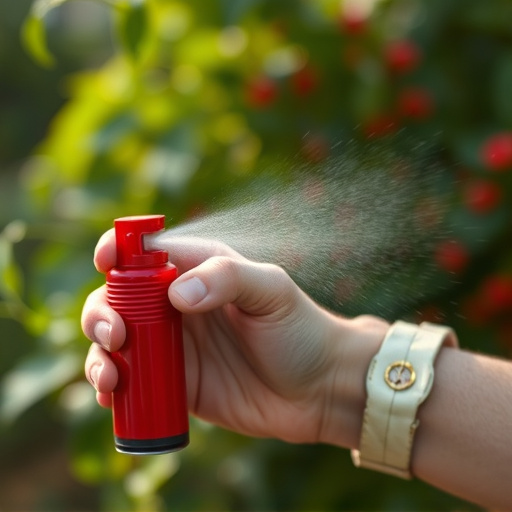Bear spray and personal pepper spray differ in range, formula, and deployment. Bear spray is long-range, for open spaces, against bears, while personal pepper spray is close-quarters, urban defense with higher capsaicin. In riot control, bear spray creates barriers for retreat or initial suppression, personal pepper spray disrupts vision and breathing in confined areas. Choice depends on disturbance nature, terrain, and training ensures safe effectiveness.
Riot control agents are powerful tools in law enforcement, but their use comes with stringent legal frameworks. This article delves into the distinction between bear spray and personal pepper spray, exploring their unique features and effects. We also uncover effective deployment strategies for law enforcement agencies, focusing on how these tactics can mitigate risks while ensuring public safety during civil unrest or high-risk situations. Understanding the legal nuances surrounding riot control agents is crucial for responsible and compliant policing practices.
- Understanding Riot Control Agents: Legal Frameworks
- Bear Spray vs. Personal Pepper Spray: Features and Effects
- Effective Deployment Strategies for Law Enforcement
Understanding Riot Control Agents: Legal Frameworks
Riot control agents, including bear spray and personal pepper spray, are powerful tools employed by law enforcement to manage and disperse large crowds during civil unrest or high-tension situations. These agents operate by either causing temporary blindness, pain, or irritation, enabling officers to regain control of a volatile environment. However, their use is not without legal considerations.
The legal frameworks governing riot control agents vary across jurisdictions, with many countries establishing specific regulations for their deployment. For instance, the application of bear spray vs. personal pepper spray might be subject to different rules and restrictions. Bear spray, known for its long-range effectiveness, may be authorized for use against aggressive animals or individuals posing a significant threat. In contrast, personal pepper spray, designed for close-quarters combat, often requires clearer legal guidelines regarding usage to prevent abuse and ensure the protection of both officers and civilians.
Bear Spray vs. Personal Pepper Spray: Features and Effects
Bear spray and personal pepper spray are both designed for self-defense against aggressive individuals, but they differ significantly in features and effects. Bear spray, as the name suggests, is a special type of aerosol designed to deter bears during close encounters in wild environments. It’s typically more powerful than personal pepper spray, with a much wider reach, often up to 20 feet. The main active ingredient in bear spray is capsaicin, similar to that found in chili peppers, which causes temporary blindness and respiratory distress in the target.
In contrast, personal pepper spray is tailored for close-quarters self-defense scenarios, like city streets or crowded venues. It’s generally less potent than bear spray but offers better control in confined spaces. The primary difference lies in the concentration of capsaicin; personal pepper spray contains a higher percentage of this ingredient per unit volume, making it more effective at close range. Additionally, most personal pepper sprays come with features like holsters and safety mechanisms designed to ensure easy deployment during distress situations.
Effective Deployment Strategies for Law Enforcement
In the arsenal of riot control agents, both bear spray and personal pepper spray serve distinct purposes. Law enforcement agencies must understand their unique properties to deploy them effectively during crowd control situations. Bear spray, with its non-lethal yet powerful formula, is designed to create a barrier between officers and aggressors, providing crucial time for tactical retreat or reinforcement. Its wide range and ability to temporarily disable through irritation make it ideal for open spaces and initial riot suppression.
On the other hand, personal pepper spray focuses on direct impact, disrupting visual and respiratory functions. This makes it more suitable for confined areas where officers need immediate, close-range protection. The choice between bear spray and personal pepper spray depends on the nature of the disturbance, terrain, and available backup. Proper training in deployment techniques ensures agents maximize these tools’ effectiveness while minimizing risks to both public safety and officer well-being.
In conclusion, both bear spray and personal pepper spray serve as essential tools in law enforcement’s arsenal for riot control. Each has distinct features and effects, with bear spray offering broader range and longer-lasting protection, while personal pepper spray provides intense, targeted disruption. Effective deployment strategies, tailored to specific scenarios, are crucial for maximizing their potential. By understanding the legal frameworks governing these agents and adopting informed deployment practices, law enforcement can ensure public safety during high-risk situations, showcasing a balanced approach between crowd control and individual rights protection.
